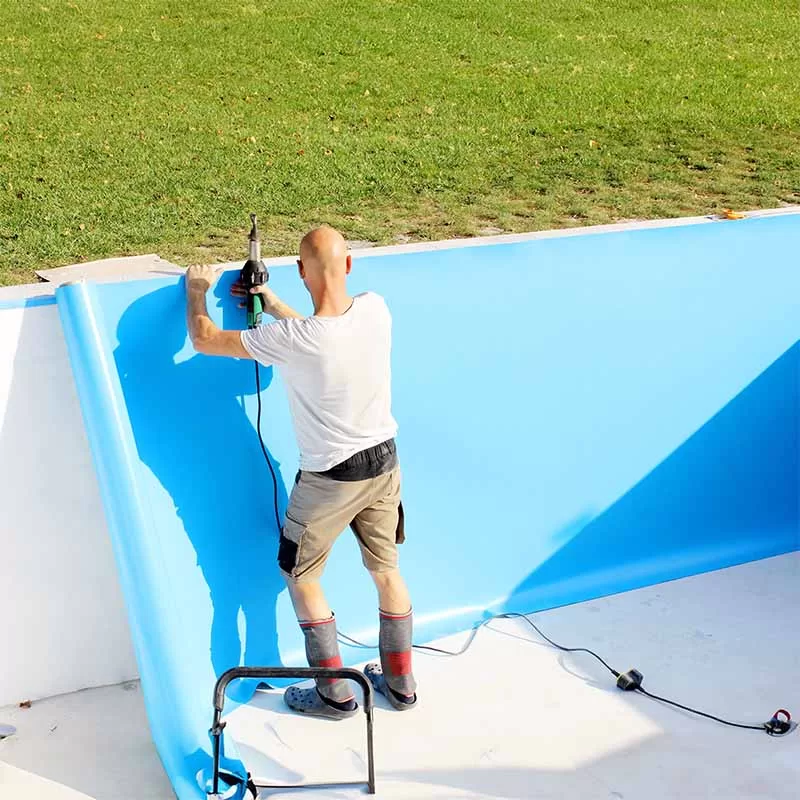FREE Standard Shipping On All Orders $100 or More!*

Vinyl Pool Coping Replacement
If your vinyl pool coping is old, faded, rusted, dented and cracked - this blog post is for you! Maybe you've spent countless hours on your hands and knees, prepping, patching and painting your 30+ year old vinyl pool coping. To replace the coping, you first have to get to it, which means removing whatever is on top of it. Here are a few tips for replacing your vinyl pool coping.
Cutting the Pool Deck

If it is a finished concrete edge, or you have a concrete pool deck poured into and up to a plastic or aluminum coping, it can be a little more difficult, as you would need to cut the concrete about 1 ft back from the coping edge, bust it up and then remove it.
Also, when the pool deck is poured right up into the pool coping, the pool coping and the liner track are joined. Which means you'll also most likely need to replace the liner when you replace this type of pool coping.
- Rent a walk behind cut saw with a 12-14" diamond blade saw.
- Snap a chalk line on the deck, put on gloves, goggles, ear plugs.
- Cut in straight lines, slowly. Hold 'er steady as it cuts thru rebar.
- Rent a rotary hammer drill with spade bit to bust up the concrete.
- Be careful not to damage the kickers, pool wall or horizontal shelf.
Removing the Old Coping
Once you have reached the pool coping it is usually screwed into the pool wall about every foot or so around the whole pool. After you have removed the screws you can pry up the old coping and clean up the surface. Most pools have a 6-8" shelf at the top of the pool wall. Be careful with it, as it may be fragile, or rusty and pitted. If needed, use a wire wheel on corroded spots and treat with heavy epoxy sealant.
Installing the New Coping

Plastic or aluminum coping
Installing aluminum or plastic coping involves securing the 4' - 8' coping lengths to the top of the pool wall with stainless steel screws or fasteners. You can buy corner pieces of different inside and outside radius. It is a good idea to lay a bead of caulking or sealant underneath each coping strip, before you screw it down. This is to keep water or moisture from moving between the pool wall and the pool coping. If the top of the wall is in very bad shape, completely rusted out, you can use angle iron or sheet metal to cover and strengthen that area, and to support and secure the new pool coping.
Cantilever pool decks
Use removable foam pads that attach to the pool wall, along with the flat type of pool coping strip that secures to the top of the pool wall. With the foam forms in place, a concrete pool deck can be poured up to and overhanging the pool edge. Most concrete pool deck companies use Stegmeier Forms, and will have options.
Stone or brick coping
You would basically use an adhesive, such as a thin set or medium bed mortar, to secure the block, brick or paver on top of the vinyl coping strip. Fill in behind the track to make it a flat surface, and then lay the brick or stone on top. Use a string line to keep the front and back edges sharp. On brick or block, use spacers between four consistent grout joints.
After the stones have set-up on top of the pool wall, the grout joints in between can be filled with mortar. Behind the new brick or block pool coping, an expansion joint of 1/2" should be left between the cut pool deck and the stone. Fill this joint with foam backer rod and a pool caulk like Deck-O-Seal.
Pitfalls of Vinyl Pool Coping Replacement
Such as with any extreme vinyl pool renovations like this, other issues may occur that you weren't planning on...
- Your deck may slip away from the pool wall if that's all that was holding it in place.
- The top of the pool wall may be damaged and require repair.
- If changing the height of the track or coping, make sure your new liner matches the new track height.
Should you replace your pool coping?
If the coping is in good shape, but appearance wise the aluminum is scratched or the paint or coating is coming off, you can repaint it with a coping paint and make old coping look brand new.
I would not suggest changing pool coping if you do not really need to, as it is a big project. But if it's something that has to be done, it is definitely something a home owner with a little bit of know how and patience can accomplish.